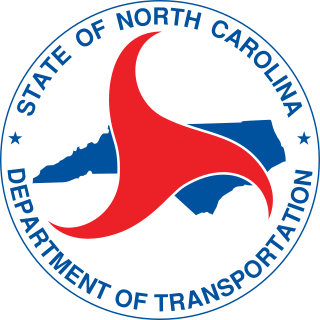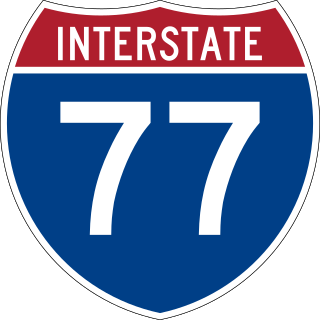Related Research Articles

Mooresville is a town located in the southwestern section of Iredell County, North Carolina, United States, and is a part of the fast-growing Charlotte metropolitan area. The population was 50,193 at the 2020 census, making it the most populous municipality in Iredell County. It is located approximately 25 miles (40 km) north of Charlotte.

CSX Transportation, known colloquially as simply CSX, is a Class I freight railroad company operating in the Eastern United States and the Canadian provinces of Ontario and Quebec. Operating about 21,000 route miles (34,000 km) of track, it is the leading subsidiary of CSX Corporation, a Fortune 500 company headquartered in Jacksonville, Florida.

The Norfolk Southern Railway is a Class I freight railroad operating in the Eastern United States. Headquartered in Atlanta, the company was formed in 1982 with the merger of the Norfolk and Western Railway and Southern Railway. The company operates 19,420 route miles (31,250 km) in 22 eastern states, the District of Columbia, and has rights in Canada over the Albany to Montreal route of the Canadian Pacific Kansas City. Norfolk Southern Railway is the leading subsidiary of the Norfolk Southern Corporation.

The Southern Railway was a class 1 railroad based in the Southern United States between 1894 and 1982, when it merged with the Norfolk and Western Railway (N&W) to form the Norfolk Southern Railway. The railroad was the product of nearly 150 predecessor lines that were combined, reorganized and recombined beginning in the 1830s, formally becoming the Southern Railway in 1894.

The Southeast Corridor (SEC) is a proposed passenger rail transportation project in the Mid-Atlantic and Southeastern United States to extend high-speed passenger rail services from the current southern terminus of the Northeast Corridor in Washington, D.C. Routes would extend south via Richmond and Petersburg, Virginia, with a spur to Norfolk in Virginia's Hampton Roads region; the mainline would continue south to Raleigh, Durham, Greensboro, and Charlotte, North Carolina. Since the corridor was first established in 1992, the U.S. Department of Transportation (USDOT) has extended it further to Atlanta and Macon, Georgia; Greenville and Columbia, South Carolina; Jacksonville, Florida; and Birmingham, Alabama.

The North Carolina Transportation Museum is a museum in Spencer, North Carolina. It is a collection of automobiles, aircraft, and railway vehicles. The museum is located at the former Southern Railway's 1896-era Spencer Shops and devotes much of its space to the state's railroad history. The museum has the largest collection of rail relics in the Carolinas. Its Back Shop building of nearly three stories high is notable for its size, two football fields long.
The Charlotte Area Transit System (CATS) is the agency responsible for public transportation in the Charlotte metropolitan area. CATS operates bus and rail transit services in Mecklenburg County and surrounding areas. Established in 1999, CATS' bus and rail operations carry about 320,000 riders on an average week. CATS is governed by the Metropolitan Transit Commission and is operated as a department of the City of Charlotte. In 2023, the system had a ridership of 13,476,600, or about 44,100 per weekday as of the second quarter of 2024.

The North Carolina Department of Transportation (NCDOT) is responsible for building, repairing, and operating highways, bridges, and other modes of transportation, including ferries in the U.S. state of North Carolina.

Charlotte station is an Amtrak station located at 1914 North Tryon Street, about 1.5 miles (2.4 km) to the northeast of Uptown Charlotte. Owned by Norfolk Southern, it is located near that railroad's yard outside Uptown.
The Piedmont & Northern Railway was a heavy electric interurban company operating over two disconnected divisions in North and South Carolina. Tracks spanned 128 miles (206 km) total between the two segments, with the northern division running 24 miles (39 km) from Charlotte, to Gastonia, North Carolina, including a three-mile (5 km) spur to Belmont. The southern division main line ran 89 miles (143 km) from Greenwood to Spartanburg, South Carolina, with a 12 mi (19 km) spur to Anderson. Initially the railroad was electrified at 1500 volts DC, however, much of the electrification was abandoned when dieselisation was completed in 1954.

Interstate 77 (I-77) is a part of the Interstate Highway System that runs 610.10 miles (981.86 km) from Cayce, South Carolina to Cleveland, Ohio. In the U.S. state of North Carolina, I-77 travels a total of 105.7 miles (170.1 km) from the South Carolina state line in the city of Charlotte to the Virginia state line north of Mount Airy. The major landscapes traversed by I-77 include the city of Charlotte and its urban core, the smaller suburban communities in the Piedmont region, and the rural foothills of Western North Carolina. The Interstate has one auxiliary route, I-277, a partial beltway around Uptown.
The Manassas Gap Railroad (MGRR) ran from Mount Jackson, Virginia, to the Orange and Alexandria Railroad's Manassas Junction, which later became the city of Manassas, Virginia. Chartered by the Virginia General Assembly in 1850, the MGRR was a 4 ft 8 in narrow gauge line whose 90 completed miles of track included 38 miles (61 km) of 60 pounds-per-yard T-rail and 52 miles (84 km) of 52 pounds-per-yard T-rail. A total of nine locomotives and 232 cars were operated on the line, serving 20 stations.
The Lynx Red Line is a proposed commuter rail service, connecting the towns in northern Mecklenburg and southern Iredell counties to Uptown Charlotte, North Carolina. In 2019, after a reevaluation of the entire corridor, the Charlotte Area Transit System (CATS) decided to move forward with BRT and shelve the commuter rail; which had been met with frustration by various city leaders and residents impacted by it.

The North Carolina Railroad is a 317-mile (510 km) state-owned rail corridor extending from Morehead City, North Carolina, to Charlotte. The railroad carries over seventy freight trains operated by the Norfolk Southern Railway and eight passenger trains daily. The railroad works with the North Carolina Department of Commerce and the North Carolina Department of Transportation on capital improvement projects.

Gulf & Ohio Railways is a holding company for four different short-line railroads in the Southern United States, as well as a tourist-oriented passenger train, and locomotive leasing and repair service through Knoxville Locomotive Works. Gulf & Ohio maintains its corporate headquarters in Knoxville, Tennessee.
Transportation in the city of Charlotte, North Carolina includes a large and growing mass transit and rail system, a major international airport, and several controlled-access highways.

Charlotte Gateway Station is a future intermodal transit station in Charlotte, North Carolina, United States. Currently operating as a streetcar stop for the CityLynx Gold Line, with an adjoining bus station for Greyhound Lines intercity buses, it is the centerpiece of the overall 19-acre (7.7 ha) Station District, and it will serve Charlotte Area Transit System (CATS) bus lines, the Lynx Silver Line light rail, and Amtrak intercity trains. The district will also include parking facilities, mixed-use development and an elevated greenway. Estimated at a cost of $800.1 million for full implementation of all public and private components, the project will be built in three phases, with Amtrak service tentatively scheduled to start in 2026–2027.
The Alexander Railroad Company is a Class III shortline railroad operating in North Carolina. The railroad has 18 miles of track that runs northwest from Statesville to Taylorsville, North Carolina.
The Carolina & Northwestern Railway (Ca&NW) was a railroad that served South Carolina and North Carolina from 1897 until January 1, 1974. The original line was operated by the Ca&NW as a separate railroad controlled by the Southern Railway until 1974 when the name was changed to the Norfolk Southern Railway. On June 1, 1982, Southern Railway and Norfolk and Western Railroad merged to form Norfolk Southern Railway. Choosing to use the name 'Norfolk Southern Railway' for the merger, in 1981, the original Ca&NW line along with original Norfolk Southern Railway was renamed Carolina and Northwestern once again. In the early 1950s several shortline subsidiaries of the Southern Railway were leased to the Ca&NW for operation, with these lines remaining a part of the Ca&NW into the 1980s.
The Thermal Belt Railway is a Class III shortline railroad that operates for freight service on an irregular schedule on a former CSX line from Bostic to Forest City and on a former Norfolk Southern line from Forest City to Alexander Mills, North Carolina. Total mileage is 8.5 miles (13.7 km). Connections are made with CSX at Bostic. Rail is 85 pounds.
References
- ↑ "Atlantic Tennessee & Ohio", Tarheel Press, retrieved 2021-04-05
- ↑ "Charlotte, N.C., still hoping for Red Line despite Class 1's resistance to share track". Railway Track and Structures. 2020-01-28. Retrieved 2021-04-08.
- ↑ Lenoir, Walter W. (1854). Atlantic, Tennessee and Ohio Rail Road. University of North Carolina at Chapel Hill University Library. [Lenoir? N.C. : s.n.]
- ↑ "AT&O-Statesville to Charlotte". WVNC Rails. Retrieved 2021-04-05.
- ↑ "North Carolina Railroads - Atlantic, Tennessee & Ohio Railroad". www.carolana.com. Retrieved 2021-04-05.
- ↑ Pressley, Robert (2004). Traffic Separation Study (PDF). Gannet Fleming.
- ↑ Sullivan, Lee (February 17, 2021). "Red Line commuter rail: 'Priority' or 'pipe dream?' | Lake Norman Publications". www.lakenormanpublications.com. Retrieved 2021-04-08.
- ↑ "Norfolk Southern to Charlotte: You can't use our tracks for the Red Line". wcnc.com. 9 February 2021. Retrieved 2021-04-08.
- ↑ "Mazeppa Road Flyover Rail Crossing". National Environmental Policy Act. The Ferguson Group. April 15, 2019.
- ↑ Today, Cornelius; Newsroom (2023-04-27). "Foamex plant will close down". Cornelius Today. Retrieved 2023-07-27.
{{cite web}}:|last2=has generic name (help) - ↑ "Manufacturer FXI to close Cornelius facility, laying off nearly 60 workers". WSOC TV. 2023-05-02. Retrieved 2023-07-27.
- ↑ "Norfolk Southern says it's willing to deal on the Red Line". WFAE 90.7 - Charlotte's NPR News Source. 2023-10-18. Retrieved 2023-10-18.